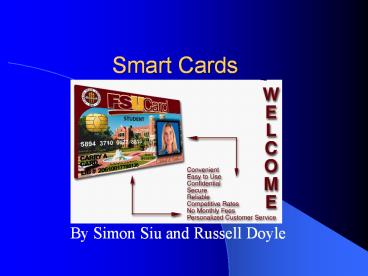Smart Cards - PowerPoint PPT Presentation
Title:
Smart Cards
Description:
Smart Cards By Simon Siu and Russell Doyle Overview Size of a credit card Small embedded computer chip Memory cards Processor cards Electronic purse cards (FSU ID ... – PowerPoint PPT presentation
Number of Views:511
Avg rating:3.0/5.0
Title: Smart Cards
1
Smart Cards
- By Simon Siu and Russell Doyle
2
Overview
- Size of a credit card
- Small embedded computer chip
- Memory cards
- Processor cards
- Electronic purse cards (FSU ID card)
- Security cards
- Processor cards require a reader
3
History of Smart cards
- Patented in 1970s (several different designs)
- 1983 first mass use in France for pay phone
- 1992 second mass use again in France for debit
cards - 1993 Visa, MasterCard, Europay agreed on a
standard (EMV) - Contactless technology is the new trend
4
Hardware Chip is accessed electronically via
gold plate
5
Smart card vs. Magnetic strip card
- Smart card is more secure
- Data encryption ability
- Difficult to access data without terminal
- Smart card is more expensive
- Smart card is less durable
6
Usage
- Banking
- ATM
- Payment
- Like credit card
- Access control
- Certificate holder (able to do triple DES)
- Id
- Information storage
7
Prime examples
- Medical application Germany issues smart cards
to all citizens - India drivers licenses (becoming popular in
other countries) - China transit (GuongZhou)
- England tracking device in airports
8
Programming the Card
- OpenCard
- Java interface, Java Electronic Commerce
Framework (JECF) - PC/SC
- Windows based interface
9
Modeling Security Threats
- Breaking Up Is Hard To Do Modeling Security
Threats for Smart Cards by Schneier and Shostack
10
Smart Cards handicap
- Functionality is split in unusual ways compare to
a computer - Unable to interact with the world without outside
peripherals - Multiple parties
11
Cardholder
- Holding the card
- May or may not control the info in card
- Does not control the protocols, software, or
hardware in the card system
12
Data Owner
- May or may not control data in the card
- Digital certificates
- Amount of money in account
13
Terminal
- Control all I/O to and from the card
- Phone
- ATM
- Set-top box
14
Card Issuer
- Control operating system running on the card
- Initial data
- Card manufacturer
- Software manufacturer
15
Examples of Trust Splits in Smart card systems
- Digital Stored Value Card
- Cash card
- Mondex
- VisaCash
- Digital Check Card
- Similar to cash card
- Card owner is also the data owner
- Prepaid Phone Card
- Value card
- Account-based Phone Card
- Account number
16
Continues
- Access Token
- Key to login or authenticatio protocol
- Web Browsing Card
- Cash card
- Cardholder and terminal owner are the same
17
Continues
- Digital Credential Device
- Digital certificates or ther credentials
- Cardholder and data owner are the same
- Kerberos
- DSSA/SPX
- Key Storage Card
- Key
- Multi-Function Card
18
Threats
- Attack is an attempte by one or more parties
involved in a smart card transaction to cheat - Interfere with one or more parties
- Inside vs Outside Attacks
- One of the parties
- Outsider stealing a card
19
Motives for Attack
- Financial theft
- Impersonation attack gain access
- Privacy attack
- Publicity attack
20
Classes of Attack
- Attack by the Terminal against the cardholder or
data owner - Fake ATM machines
- Assume we trust the terminal
- Preventions
- Limit the time to modify
- Limit the amount of reduced at a given time
- Real prevention is monitering by back-end system
21
Continues
- Attack by the cardholder against the terminal
- Fake cards with rogue software
- Preventions
- Good protocol design
- Hard-to-forge physical aspects
- Hologram on Visa
22
Continues
- Attack by the cardholder against the data owner
- Pay-TV access cards
- Reverse-engineering
- Defeat tamper-resistance
- Fault analysis
- Attack by the cardholder against the issuer
- Randomly access an acount with account-based
phone cards - If there is a key, capture the key and use it
23
Continues
- Attack by the cardholder against the software
manufacturer - One application on a smard card to subvert
another running on the same card.
24
Conclusion on Security
- Resistance
- Make specific attacks harder stronger
cryptographic protocols, increase
tamper-resistance - Few splits to eliminate certain attacks altogeter
- Example cardholder is also the data owner which
means no cardholder attacking data owner - Adding screen and data entry to the card
- Increase the cost
- More Transparency
- Open publication leads to review and analysis
- Cleanly separating roles
- Example Mondex system with various terminals
- User can check his/her account in any one of them
25
Evolution of Smart cards or lack there of
- Why is it not popular in America yet?
- Social environment
- Split government systems
- Class differences
- Market forces
- Cost vs. Benefit
26
Future of smart cards
- Security of smart card is similar with the
security of PC - New technology help to further secure smart
system - Digital display on the card
- Contact vs. Contactless
27
References
- http//www.schneier.com/paper-smart-card-threats.p
df - http//en.wikipedia.org/wiki/Smart_card
- http//smartcard.nist.gov/faq.html































